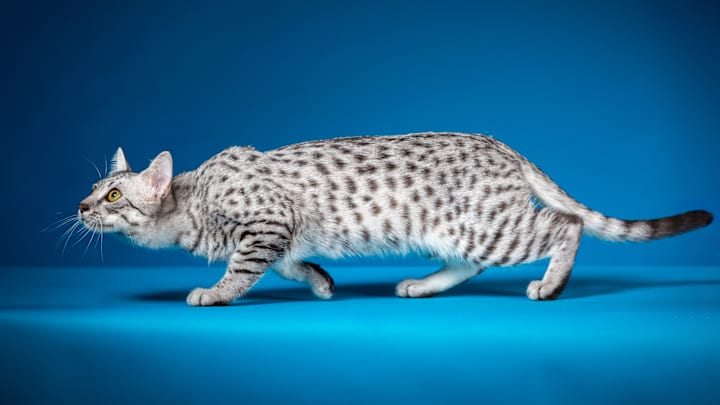With its spotted coat and large green eyes, the Egyptian Mau looks like a miniature jungle cat. Here are six facts about the exotic-looking feline.
1. The Egyptian Mau might not actually be from Egypt.
The Egyptian Mau’s name is derived from the Middle Egyptian word mjw, which means cat. But contrary to its name, it’s unclear whether the modern Egyptian Mau actually originated in Egypt—even if it does share more than a passing resemblance with the spotted felines depicted on the walls of Pharaonic palaces and temples. In fact, DNA analysis suggests that the Mau might be from Europe, and is genetically similar to kitties including American-bred Turkish Angoras. In short, no one quite knows where the cat came from, although spotted cats have been sighted in modern-day Egypt.
2. An Italian princess rescued the Egyptian Mau breed.
Cat fanciers bred and exhibited Maus in Europe until World War II, when attention toward the cat waned and it nearly went extinct. The breed was saved in the 1950s when Russian princess Natalie Trubetskaya (sometimes Troubetskoy), living in exile in Italy, was given a Mau that was reportedly imported from the Middle East. Trubetskaya took a shine to the spotted feline breed, and when she emigrated to New York City in 1956, she brought along three Mau cats. She used these kitties to establish the Fatima Egyptian Mau cattery, which produced many of the ancestors of today’s Egyptian Maus in America.
Once the Mau arrived in the U.S., fanciers continued the rare breed’s bloodline by outcrossing it with other cats, and imported more Maus from Egypt and India. In 1977, the Mau was granted championship status by the Cat Fanciers’ Association (CFA), the world’s largest registry of pedigreed cats.
3. The Egyptian Mau is one of the only naturally spotted domestic cat breeds.

Feline enthusiasts say the Egyptian Mau is one of the only naturally spotted domestic cat breeds. (The other is a cat called the Bahraini Dilmun Cat, a rare feline that hails from Bahrain. In the past few decades, other cat breeds have been specifically bred to have spots, often by cross-breeding with closely related wild species, and so don’t officially count yet.) Its distinctive short coat is randomly dotted with darker splotches that can be small, large, round, oblong, or irregularly-shaped.
As for other markings, Egyptian Maus have exotic-looking banded “mascara“ lines that begin at the eyes’ outer corners, extend along the cheek, and curve upwards toward the ears. Their foreheads bear typical tabby “M“ marking, and their tails are banded and dark-tipped.
The medium-sized, athletic cat comes in three competition-approved shades, including silver, bronze, and smoke. There can also be black, blue silver, blue spotted, blue smoke, and blue Egyptian Maus. (These cats aren’t allowed to compete in shows as “Champion-status“ Maus.)
Aside from its coat, the Mau’s most striking feature is its wide-set eyes, which are a bright “gooseberry green,” and give its wedge-shaped face a perpetually worried-looking expression.
4. Egyptian Maus are fast runners.
Don’t get into a race with an Egyptian Mau—it will probably win. The kitty is said to be the fastest of the domestic cats, and is known to clock up to 30 miles per hour.
Thanks to its unusually long hind legs, the Egyptian Mau is physically built for speed. The Mau also has a long skin fold underneath its belly, which extends from its flanks to the knees of its hind legs (kind of like a cheetah’s furry stomach flap). This trait helps the Mau’s back legs stretch further backwards, allowing it to sprint and leap with ease.
5. The Egyptian Mau is a shy (but friendly) cat.
Egyptian Maus are friendly and loving with their main owners, but they’re slow to warm up to other people or pets. The Mau is also a possessive feline—meaning unless you socialize it with another animal while it’s young, you might have to settle for running a one-cat household.
6. Egyptian Mau cats have longer pregnancies than other felines.

Egyptian Maus tend to have a longer gestational period than most cats. While average felines give birth after 65 to 67 days of pregnancy, Maus remain pregnant for an average of 73 days.
A version of this story originally ran in 2016; it has been updated for 2022.
